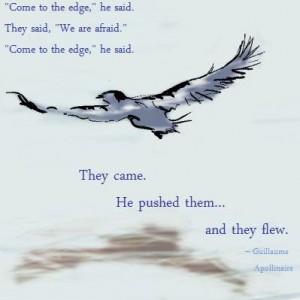THIS POST IS FOR WRITERS:
How To Kill Strong Narrative
As a reader, I hate Passive Voice as much as any other writing sin—and more than most. As an editor, I darn near pop an aneurysm when I see it.
1) Readers view Passive Voice as weak and indecisive, as if the author lacks confidence.
…a) When readers see that, they too lose confidence—and interest.
…b) The effect is subtle; for many readers, it occurs at a subconscious level. They may not know why they don’t like it, but they’ll dislike it, all the same.
2) Readers invest themselves in the characters’ actions, not in actions that happen as if out of thin air.
…a) I refer to this nasty Passive Voice practice as “An Act without an Actor.” See my hub entry, Passive Voice: A Writing Sin – Part 2, for more on this.
…b) Without a character to invest in, readers lose interest.
…c) The only real exception to this is description of Setting.
3) Writers tend to scratch the subject of the larger paragraph/segment from that sentence, or at least relegate them to secondary status, and convert the object to the subject.
…a) Readers rarely care for this: “A rock skipped across the pond.”
…b) They won’t like this: “The rock was skipped across the pond by Danny.”
…c) However, they might like this: “Danny skipped a rock across the pond.”
…d) Writers who engage in this nasty Passive Voice practice what I call “Placing the Cart before the Horse.” See my hub entry, Passive Voice: A Writing Sin – Part 3, for more on this.
4) Passive Voice often results from the author’s attempt not to commit, not to offend, not to stand firm. His fear and anxiety often lead him down a meandering, excruciating, wordy route to the end of the sentence.
As Stephen King says in his book, On Writing: A Memoir of the Craft (Scribner):
Two pages of the passive voice—just about any legal document ever written, in other words, not to mention reams of bad fiction—make me want to scream. It’s weak, it’s circuitous, and it’s frequently tortuous, as well. How about this: My first kiss will always be recalled by me as how my romance with Shayna was begun. Oh, man—who farted, right? A simpler way to express this idea—sweeter and more forceful, as well—might be this: My romance with Shayna began with our first kiss. I’ll never forget it. I’m not in love with this because it uses with twice in four words, but at least we’re out of that awful passive voice.
Since Mr. King hates “with” twice in four words, how about this as another alternative: My romance with Shayna began when we first kissed. What a moment!
I will now illustrate further through a series of specific examples I’ve seen in pieces I’ve edited. As always, I shall keep confidential the authors’ names and story titles, to protect the not-so-innocent. (Insert chuckle here.)
BAD: Susan and the old man had chipped enough flint to make more tools than would ever be used.
GOOD: Jeremy and the old man had chipped enough flint to make more tools than they would ever use.
BAD: Jimmy was comforted by the three small pups Mike had left behind, but he still felt empty.
GOOD: The three small pups Mike had left behind comforted Jimmy, but he still felt empty.
BAD: Mary shuffled on the rug until she was squarely facing her son.
(Note: Writers commonly use conjugations such as “was doing anything” in a Past Tense narrative, but it rarely satisfies. If you suffer this bad habit, break it!)
GOOD: Mary shuffled on the rug until she squarely faced her son.
BETTER: Mary shuffled on the rug, spun on her heels and faced her son. She stood close enough to feel his breath on her nose.
BAD: Time is surely a measurement that could not have been marked in a cold and motionless void.
(Note: The author also mixed verb tenses here, using “is” in a Past Tense narrative.)
GOOD: Time was surely without measurement in that cold and motionless void.
BETTER: Time held neither measure nor meaning in that cold and motionless void.
BAD: Speed, time, and distance are so closely related that one can’t be considered without involving the other two.
(Note: Sometimes you have to stretch yourself a bit. Opportunities like this one are where writers earn their keep.)
GOOD: Speed, time and distance link inexorably, and we can’t consider one without involving the other two.
BETTER: Speed, time and distance function as a single, three-part equation, for one exists only where the other two are present.
BAD: The words were not spoken so much as a command as a gentle prodding, an understanding and empathy that gave Bill strength.
GOOD: He did not speak the words as a command so much as a gentle prod, with understanding and empathy that gave Bill strength.
BETTER: John offered the words not as a command, but as a gentle prod, with understanding and empathy to give Bill strength.
BAD:The wound had been made, and now the men could not be placated by my yielding. Without John willing to throw himself into the fray, I would surely be struck down by their numbers. As detestable as it seemed, my only recourse was undeniable: I would have to break through their lines and flee.
(Note: As is so often the case, Passive Voice led the author down a long, circuitous, Wordy path. On top of everything else, the following alternative chops the original word count of 54 down to 43, a 20% reduction.)
GOOD: I’d already inflicted the wound, and I would not placate the men now by yielding. If John didn’t throw himself into the fray, I would surely fall to their numbers. My only recourse, though detestable, was undeniable: break through their lines and flee.
Let me urge you, as I do all my clients, to make these your watchwords: Keep it strong and direct!
If you’ve studied the art and craft of writing at all, you no doubt have seen these warnings against Passive Voice. Nonetheless, I shall now call out the reinforcements, as it were.
The Art of Fiction: Notes on Craft for Young Writers – John Gardner (Vintage Books)
I’ve excerpted the following, in applicable segments, from pages 98-100:
In the work of beginning writers, especially those weak in the basic skills of English composition, the usual mistake is that the writer distracts the reader by clumsy or incorrect writing… But the standard third-person narrator can never miss. If the narrator slips into faulty syntax, the reader’s mind tracks away from the action [sic] to the problem of figuring out what the sentence means. The distraction is almost certain to be emotional as well as intellectual, since the reader has every right to feel that the writer’s business is to say what he means clearly…
Clumsy writing is an even more common mistake in the work of amateurs, though it shows up even in the works of very good writers…
The most obvious forms of clumsiness, really failures in the basic skills, include such mistakes as inappropriate or excessive use of the passive voice…
Except in stock locutions, such as “You were paid yesterday,” “The Germans were defeated,” or “The project was abandoned,” the passive voice is virtually useless in fiction except when used for comic effect, as when the writer mimics some fool’s slightly pompous way of speaking or quotes some institutional directive. The active voice is almost invariably more direct and vivid: “Your parrot bit me” as opposed to (passive) “I was bitten by your parrot.” …In a story presented by the conventional omniscient narrator—an objective and largely impersonal formal narrative voice like, say, Tolstoy’s—the passive voice is almost certain to offend and distract…
On Writing Well – William Zinsser (Harper Collins)
I’ve excerpted the following, in applicable segments, from pages 108-109:
Use active verbs unless there is no comfortable way to get around using a passive verb. The difference between an active-verb style and a passive-verb style—in clarity and vigor—is the difference between life and death for a writer.
“Joe hit him” is strong. “He was hit by Joe” is weak. The first is short and vivid and direct; it leaves no doubt about who did what. The second is necessarily longer and it has an insipid quality; something was done by somebody to someone else. A style that consists mainly of passive constructions, especially if the sentences are long, saps the reader’s energy. Nobody quite knows what is being perpetrated by whom and on whom.
I use “perpetrated” because it’s the kind of word that passive-voice writers are fond of. They prefer long words of Latin origin to short Anglo-Saxon words—which compounds their trouble and makes their sentences still more glutinous…
Verbs are the most important of all your tools. They push the sentence forward and give it momentum. Active verbs push hard; passive verbs tug fitfully. Active verbs also enable us to visualize an activity because they require a pronoun or a noun to put them in motion… Don’t choose one that is dull or merely serviceable. Make active verbs activate your sentences, and try to avoid the kind that need an appended preposition to complete their work. Don’t “set up” a business that you can “start” or “launch.” Don’t say that the president of the company “stepped down.” Did he “resign?” Did he “retire?” Did he “get fired?” Be precise. Use precise verbs.
Make Your Words Work – Gary Provost (Writer’s Digest Books)
I’ve excerpted the following, in applicable segments, from pages 20-21:
In writing…active is more interesting than passive. …Your reader will fix his attention on the active words and phrases.
New writers often fall into the habit of casting their characters as the passive recipients of some activity, when they should be writing about people or objects doing things, making things happen.
A key to finding the active voice is to write about people, not things. “A good time was had by all,” for example, is a passive-voice sentence about good times. “Everybody had a good time” is an active-voice sentence about people.
The tip-off to these dull, passive-voice sentences is usually a compound verb such as “was driven” or “were presented.” Cash them in for sharp, short, interesting, active verbs, and your writing will work better.
The Elements of Style, by William Strunk Jr. and E.B. White (Macmillan), is another indispensable source (many refer to it as the bible for writers). They address Passive Voice on pages 18-19.
‘Til next time, remember this: Writing well is not easy. It takes work. You mustn’t be lazy.




Please follow me here: